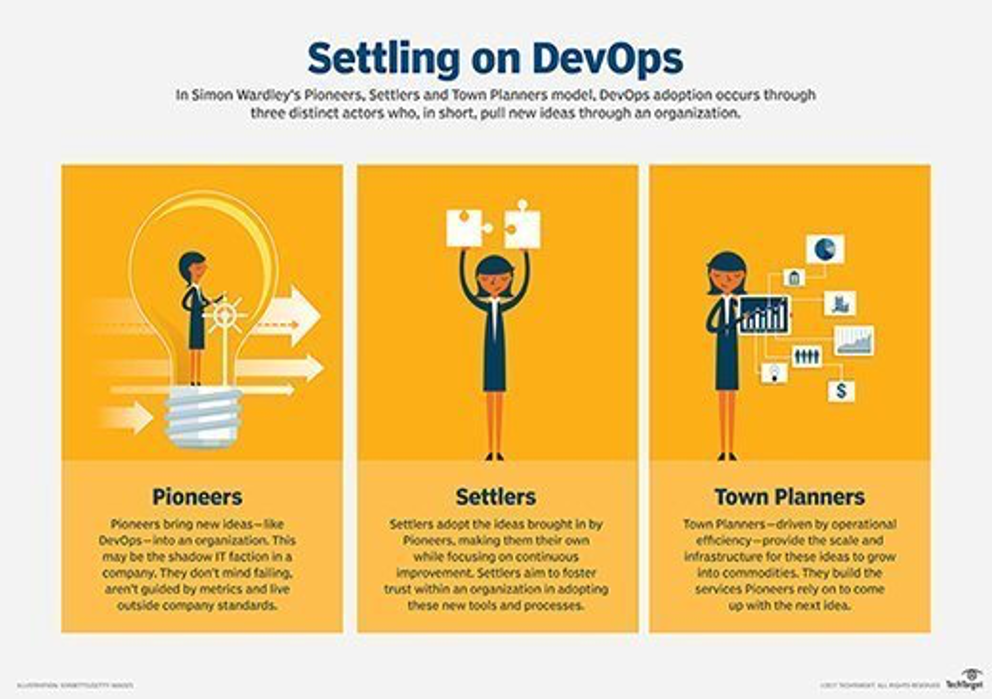14 Nov

You have seen organizations succeed and couldn’t exactly figure out what is the secret behind their success and constant delivery. You utilize agile methods to plan and develop your codes, yet, you find it a huge struggle to release a code without going through lots of ordeals.
Here, is the good news we have for you. There isn’t any need to despair! Yes, you may have been doing it wrongly! But we have got a sure fix for you. All you need to do is implement these fixes to start recording tremendous amount of success!
The truth is that for functional DevOps implementation; there is no need to hang on till the organization’s superior executive brings up a momentous initiative. What you require is to make minor, stage by stage alterations and improvements. This way, you instantly start to progress on the DevOps trip, see positive results and begin to reap the benefits.
DevOps Model
Many teams fail because they think they must stick with the maturity model. Implementation of Devops doesn’t have to concentrate on only the maturity model. There are other models that organizations can embrace to achieve the same desired result. What works for an organization may not work for another. Working on the principles and figuring out what works best in a specific scenario is the best place to start.
DevOps Maturity model
DevOps entails proper and efficient management of organizational change to be in pace with new and emerging technologies and deliver result on a recurring basis. Some organization find success with the DevOps maturity model which is based on four stages of transformations in line with Noel Burch’s four stages of learning; Unconscious Incompetence, Conscious Incompetence, Conscious Competence, and Unconscious Competence. However, the model may not be suitable for all organization and for every scenario.
Simon Wardley DevOps model

Maturity models aren’t the only models of use. Organizations can turn to the Pioneers, Settlers and Town Planners model to reach DevOps efficiency in a way that is best suited and most natural to them.
The values you get by implementing DevOps
Teamwork And Trust
The first DevOps success determinant factor is your team’s ability to build a culture of collaboration, collective responsibility, transparent system, and quicker feedback mechanism. If your team operates in siloes, you can hardly uphold the philosophy of the DevOps system. The right philosophy entails awareness of the fact that what you do affect all the members of your team and equally all other teams that take part in the release development.
Automated implementation for Fast Release
The overall goal of DevOps is fast release. If you are successfully implementing DevOps with your team, you’ll release more regularly and produce better work quality. You’ll post stable performance and your work will turn out well. Automated implementation and evaluation cycles frequently fasten release time. Insufficient or delayed feedback time destroys the speed and confidence of the team. The team’s productivity, release time and speed are enhanced with the use of an automated implementation of regularly utilized tools and practices. Automation gets rid of recurring physical tasks, results in duplicating practices, and generates dependable systems.
Easy communication and transparency of operations
To speed up the delivery time, your team needs to have the speediest feedback loop. This is the best way to thrive. For this to be possible, you must implement easy communication and transparent strategies. By doing so, you will limit hiccups and find solutions to your problems faster. It is one of the determinant factors for your success because when you delay in handling critical issues; it negatively affects users experience and limits their satisfaction.
Ability to handle Unplanned task better
Your team needs to have planned structures to face challenges and tackle tasks outside your standard work structures. These issues crop up from time to time and have a direct impact on your productivity. To make this possible, you can put processes in place and develop prioritization tactics. This way, you get your Dev and Ops teams well prepared to appropriately take care of unplanned task when they arise while at the same time concentrating on their regular planned tasks.
Implementing DevOps: Success tips
We are seeing a lot of changes happening in the business environment in exponential rates. Emerging technologies like AI, machine learning, and IoT and so on are fast re-defining the business future. Businesses that are fast at implementing these technologies will lead their competitors. Given these new technologies, DevOps requires organizations to work hard on how they can develop, deploy, test these technologies in their business environment while ensuring tight security and viewing user experience differently. In this part of the guide, you’ll learn tips to successfully implement DevOps in your organization.
- DevOps success doesn’t have to be achieved only through the maturity model alone. Implementation of the DevOps maturity model requires you to, for instance, concentrate on Infrastructure as code, engage in automated implementation, carry out test automation, and lots more. However, this model doesn’t take into account the real difficulties that are facing each of these operational pipelines.
- What works for a small team differs from what makes the large team succeed. The reality is that what works for organizations differs and there is no model that works for all circumstances.
- Analysis of organizational operational procedures shows that factors that make organizations successful are basically dissimilar.
- A proper DevOps implementation requires a business team to perform their regular tasks differently. It requires starting off with the changes that would provide the most value to the end users. This way the momentum of the team as they gear towards organizational transformation is constantly renewed.
So, instead of jumping in with the maturity model and trying to implement it out of the box, all your team needs to do is begin with DevOps principles. Give your team the chance to decide on the changes that are making a greater impact to them so they can take charge of implementing those transformations within the business environment.
Scalability and DevOps success
DevOps scalability means different things to large and small organizations. You need to follow the rule specific to your organizations size to gain the desirable result.
Scalability of DevOps operation in a Small organization
For a small team of developers, DevOps application is less complicated. If you are a small group, all you need is to get your hands on the code, own them and work consistently on them from the start to finish. It entails being part of every stage and system until you finally release your product to the end user.
DevOps application for a small team also requires a direct focus on fulfilling the needs of end users and consistently delivering with that goal in mind. It entails each member of the team coding in response to customers feedback and working on the codes from start to the finish. DevOps practices in these circumstances require helping all the members of the team to have a good understanding of what is required of them and helping them to work as generalists.
Scalability of DevOps operation in a large organization
In a large system that unites thousands of people together, the division of labor that exists makes it hard for anyone among the group to know the entire system or be able to own it from the start to finish. To be successful in a convoluted system like this, you’ll require adequate planning:
A member of the team needs to be delegated with the responsibility of structuring out a way to unite the composite system to make it more efficient. This will help the team to deliver on a recurrent basis.
Also, the team needs to work with experts, because, it is difficult to get all the members of a large organization to understand everything involved in such a bulky system.
The way you manage a team of five, obviously, is different from how you’ll manage a team of thousand.
In this scenario, it makes sense to use a different model instead of merely relying only on the maturity model which works best for a small team. A big team like this can use the Simon Wardleys model. This commonly involves three players, the pioneers, the settlers and the town planners. These three players need work in a coordinated manner to make innovation alive in such enterprise.
Why Most enterprises struggle with DevOps practices implementation
Majorities of large business enterprise struggle with DevOps implementation because they try to mimic and replicate the practices that have proven successful for small businesses. This should not be. What these organizations need to do first is try to discover the problems that are hindering them from delivering regular result and when that is done, they must devise ways to efficiently manage, tackle and fix them.
That is the only way to succeed as a big team and come up with better results. Copying what small enterprises are doing and creating a DevOps maturity model, is not the answer!
As a big team, you need to rather concentrate on principles of DevOps to help you identify what you are doing wrong. You need to split their operating system into various micro-services. This way, you’ll have a team that is much easier to manage, resolve and sustain. It is hard to properly manage and sustain a very complicated system. Trying to re-engineer a large and firmly united system is a sheer waste of time. Only do this as the last resort. You are better off creating manageable units within the composite system.
Besides, there are DevOps practices more tailored for large, firmly united systems. However, application of DevOps principles in composite systems like this will not provide much value as when they are broken into small more manageable units. It is commonly much more inefficient to coordinate work across outsized groups than when you only manage undersized and minute factions.
Implementing successful DevOps Culture
Successful DevOps culture inherently involves cooperation among team members and all teams associated with a release. It requires cross-functional cooperation. Without cooperation, the various tools and automation that exist are a waste of time. They need to be complemented with a sincere craving of the developers and Operators to correlate. DevOps development is an agile structure that integrates operations by creating project/product-based teams in place of the traditional role-based teams.
To be successful, you need to implement strategies that promote cooperation within your team. These include sharing a common goal and engaging in joint planning to attain that goal. You will achieve it better by taking small steps at a time. Go at your own pace. Some companies are better prepared to move right away from function based role to project-based teams.
Your development team can ask suitable operation team members to be part of the sprint plans and demos. Likewise, the operations team can ask major developers to be part of the deployment process. This is a responsive and natural way to maintain the rhythm of each team’s projects, share ideas, and solve problems together. And the result you’ll get is improved efficiency.
The age-long lack of coordination among developers and operators is as a result of the absence of a common ground. Work hard to bridge that gap!
Conclusion
DevOps is real. Many companies like Capital One, Netflix and a lot more have recorded tremendous success and are reaping the fruit. Companies that are well prepared to deliver ahead of the others are definitely going to be the winners. Teams that are attentive to their users needs and can lead ahead of competitors by delivering the desired value to their customers will know no limit to their success.
It calls for working hard together and collaboration between the development and operational team. All that is required is to be in pace with the trend and begin to see user experience and satisfaction in a new light. By sharing responsibility and properly coordinating the teams of developers and operators, you’ll achieve success and consistently deliver. The team will also be energized to do better and overall, this leads to faster organizational growth.








Recent Comments